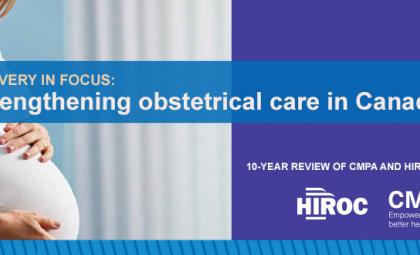Delivery in focus

HIROC AND THE CMPA RELEASE SECOND COLLABORATIVE REPORT ON OBSTETRICAL CARE IN CANADA
Tuesday, June 26, 2018 – HIROC News
HIROC and the Canadian Medical Protective Association (CMPA) both have unique and comprehensive databases that reveal the scope, risks, and patterns in the area of obstetrical safety. On June 26, the two organizations announced the release of their second collaborative report which takes a look at both data sets as they relate to obstetrical care in Canada.
We sat down with HIROC’s Joanna Noble to learn more about the report and how it can be used by HIROC subscribers.
HIROC News: This collaboration is a follow-up to the 2016 report Obstetrics Services in Canada: Advancing Quality and Strengthening Safety. How does the 2018 report compare?
Joanna: In 2016 we worked with our partners Accreditation Canada/Health Standards Organization, CMPA and Salus Global Inc. to develop a report examining the quality and safety of obstetrics in Canada. Perhaps it’s not surprising, but the analysis identified a high degree of alignment between the CMPA and HIROC’s claim data. Specifically, alignment around the risks and contributing factors associated with: fetal heart rate monitoring, interpretation, and response; induction and augmentation (i.e., intravenous oxytocin) of labour; timing of the decision and resources to perform a C-section; management of shoulder dystocia and assisted vaginal delivery (i.e., forceps and vacuum-assisted deliveries).
Due to the interest in the first report and our commitment to sharing valuable learning from our respective claims databases, HIROC and the CMPA undertook a deep dive into these shared risk areas, in particular fetal heart rate monitoring and induction and augmentation of labour. The new report also includes results from our Risk Assessment Checklists (RAC) program.
HIROC News: What specific risks can we expect to read about in the 2018 report?
Joanna: The reports provides greater insights into the case characteristics of our respective obstetrical claims (midwife claims were excluded), maternal and fetal/neonate patient outcomes, the phases of care most likely associated with incidents, as well as practitioner, team and system-level contributing factors. Interestingly there is quite a bit of alignment between the claims results and HIROC’s lowest scoring obstetrical RAC Modules (Failure to Communicate Fetal Status).
HIROC News: Does the report suggest areas for improvement with respect to organizations with labour and delivery operations?
Joanna: Absolutely. We really wanted to get down to strategy and help healthcare organizations, teams, and practitioners focus in on a few key areas. In the report you’ll find we place a lot of emphasis on three main strategies: (1) strengthening clinical decision making, (2) system issues, and (3) team communication.
Obstetrics is a high-risk practice area. While rare, outcomes for the maternal patient, and/or fetus and newborn, can be severe. From an economic burden of harm perspective, these cases can be extremely costly for the family as well as the healthcare system. This is why we’re encouraging focused strategies to improve the reliability and safety of care, such as simulation training and drills to develop more effective communication techniques, and crisis response plans.
Another key takeaway from the report is that we can all do better when it comes encouraging a safety culture that welcomes speaking up and escalating care concerns so everyone’s voice is heard and respected.
HIROC News: What do you hope healthcare organizations do with this report?
Joanna: I encourage all of our subscribers and partners to review the data and the suggested areas for improvement. Co-producing this report with the CMPA helps to enable a fulsome picture of obstetrical safety from a medical-legal lens. Taking the report and its suggestions back to your teams and starting a discussion on areas for improvement would be a great first step.
We’re also happy to answer any questions you may have about the report or HIROC’s risk management programs. Feel free to reach out any time at [email protected].
Joanna Noble is Supervisor, Healthcare Risk Management at HIROC ([email protected])